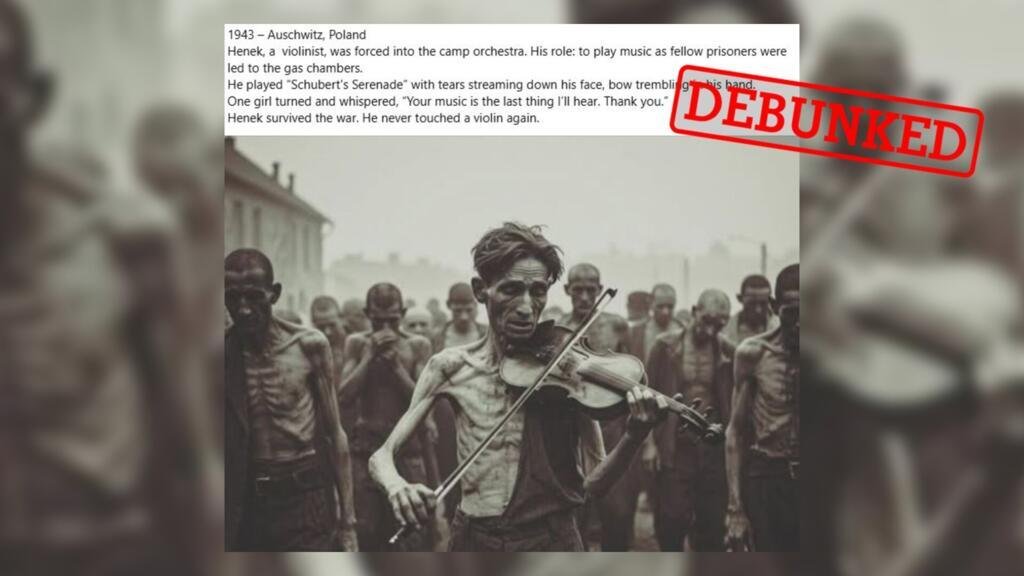Social media users have been circulating an image since early July that they say is a photo of a prisoner in the Auschwitz concentration camp, where a million Jewish people were exterminated during World War II. The photo is said to show a man named Henek, a violinist who was forced to play in the camp’s orchestra. “His role: to play music as fellow prisoners were led to the gas chambers,” reads one caption by a Facebook user. A video featuring the image of Henek was also widely shared on Facebook.

A photo and video that were generated by AI
However, as the team working at Poland’s Auschwitz Memorial wrote on X on July 6, the photo is false – it was AI-generated. The museum calls the post a “dangerous distortion” and adds that “such fabrication disrespects victims and harasses their memory”.
There are anomalies in both the photos and the video that are common in AI-generated images. If you increase the luminosity of the image to better see the details, one of the prisoners seems to be missing eyeballs. In the video, the hands of another prisoner appeared to be fused together.

A story that is fake ‘from A to Z’
Aside from the visual anomalies, the photo and video, which are supposed to document the story of a violinist who played for prisoners sent to gas chambers, aren’t credible from a historical point of view.
“This story is fake from A to Z and for a very simple reason: people sent to the gas chambers were not serenaded by an orchestra,” Tal Bruttmann, a historian specialising in the history of Auschwitz, told the FRANCE 24 Observers team.
“The camp orchestras were generally playing march music when columns of prisoners were marching to work and returning to the camp,” the Auschwitz Memorial told our team. “They were not playing for Jews who were murdered in gas chambers immediately after arrival selection.”
The scene depicted in the photo also doesn’t make sense, Bruttmann said.
“To see a guy with a violin standing in the middle of a group of prisoners is ridiculous,” he told us. “If you look at photos of the Auschwitz orchestra, you can see how they were [truly] organised.”
Drawings of the Auschwitz orchestra made by camp prisoners show that the musicians were always in a group, under the supervision of guards. As camp life was highly controlled, it is very unlikely that one solo violinist would appear without the rest of the orchestra, which is what is shown in the photo and video that have been circulating online.

Another thing that doesn’t make sense in the AI-generated image is what the prisoners are wearing.
“It doesn’t correspond with the prisoner’s uniform,” Bruttmann said. “If you look at the photos that were taken in Auschwitz by the SS, you’ll see that people didn’t go around shirtless [Editor’s note: like the man in the picture]. In a concentration camp, if you were shirtless, you were beaten or whipped.”
Moreover, the man in the image shared online isn’t wearing the striped uniform that most prisoners wore.
The Auschwitz Memorial added that prisoners didn’t wear belts like those in the AI-generated image.

A worrying trend of AI-generated fake images of the Holocaust
Representatives from the Auschwitz Memorial told our team about a growing – and worrying – online trend involving the use of AI to produce fake posts and stories about the Holocaust.
In a post published on Facebook on June 8, the Memorial warned people to stay vigilant about pages appearing to share “emotional tributes to Holocaust victims” that look like the posts shared by the museum.
“While some pages simply copy our posts, we can see more and more posts that either add AI-generated photos or are entirely fabricated,” the Memorial wrote in their post.
The Memorial added that the posts featuring AI-generated images are “dangerous distortions” of history that “contribute to confusion and the erosion of historical accuracy”.
They added that the stories accompanying these AI-generated images are often entirely fabricated, and that AI is used to generate fake photos not sourced from archives.
“They exploit Holocaust memory for clicks, shares, and reach,” the Memorial said.



